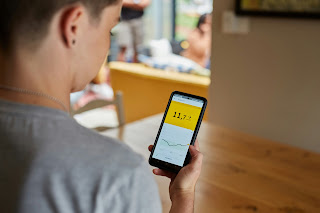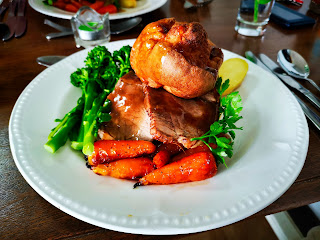Should you get a blood sugar monitor?
One of the latest nutrition crazes is tracking our blood sugar levels. I’ve seen countless posts on social media about keeping carbs under control to curb those pesky glucose spikes.
But do we actually need to?
And what does the data we get from the monitors actually
tell us?
First, let’s see what these blood sugar monitors are.
What is a continuous glucose monitor?
A continuous glucose monitor, or a CGM as it’s
affectionately shortened to, is a device that measures your blood sugar levels.
It’s normally attached to your upper arm and is connected a smart phone app to
sync the readings to.
It means someone can check if their blood sugar levels are
too high or too low and it allows people to see patterns/trends in their blood
sugars.
They were originally designed for people living with type 1 diabetes as it allowed better monitoring of blood sugar levels and so meant insulin dosing would be more accurate. If someone has type 1 diabetes, their body doesn’t any produce insulin. So, they need to check their blood sugar levels and inject the correct amount of insulin to bring their blood sugars back to normal range. People with type 2 diabetes can also use these monitors.
Unfortunately, diet culture has taken this and ran with it.
And now a CGM seems to be pushed for everyone to help them ‘understand’ their
bodies and manage their ‘sugar spikes’.
But the harsh reality is, most people don’t need one.
Do you actually need a continuous blood sugar monitor?
When we eat something containing carbohydrates, it will get
broken down into sugar and our blood sugar levels will rise. We then have the
hormone insulin to bring our blood sugar levels back down. This process is
completely normal and is what’s expected to happen. And this is what a blood
sugar monitor will show you.
I can understand having an interest in seeing how your blood
sugar level reacts to different foods. But I’ve seen companies promising
personalised nutrition programmes after 6 weeks of collecting blood sugar data,
alongside collecting stool samples. I
think this is a hefty claim to make.
It’s true that we all react differently to foods, and we’ll have different peaks and troughs in our blood sugars. We also know that an individual can have a different blood sugar response to the same food when eaten on different occasions.
But we don’t need to have a continuous glucose monitor. The highs and lows of blood sugar is normal. And the average person doesn’t need to worry about this, we also don’t have enough proof to say that it’s something we should all be doing.
It is true that persistently high blood sugar levels can contribute to having more inflammation in the body. But you don’t need a blood glucose monitor to tell you this. Having a balanced diet with wholegrain carbohydrates is the recommended way to manage blood sugar levels.
Wholegrain carbohydrates
take longer to digest and so will slow down a rise in blood sugar, and a
balanced diet with protein and fat will also slow the digestion of sugar.
Yes, having a sweet snack will cause someone’s blood sugar
to ‘spike’, but this is normal and to be expected. And our bodies are well equipped with the hormone insulin to handle
this. If it’s something we have occasionally within a balanced diet, then it’s
okay.
Are glucose hacks worth it?
I also wanted to touch on some of the ‘glucose hacks’ that
I’ve seen circulating. These are little tips to help people manage their blood
sugar levels. Again, I don’t know why there’s such a push for the average
person to obsess over their blood sugar levels, but diet culture always wants
something from us.
Let’s go through a few of the hacks and see if there’s any
merit.
Have a spoonful of vinegar before a meal – there is some scientific research that says 10-30ml of vinegar daily can help us control our
blood glucose levels after a meal. This also works if the meal is high in
carbohydrates.
It’s thought that the acetic acid in the vinegar slows down the rate at which your stomach empties into your small intestine. This means that the breakdown of carbohydrates into sugar is slowed down too.
I just don't know if it's worth it to do vinegar shots before every meal. It also ignores that fact that vinegar is very acidic and can wear away your teeth enamel.
Eat your vegetables first, then protein, then carbs –
the idea behind this is that if at each meal someone eats the vegetables first, it coats the
stomach and slows down the digestion of the carbohydrate eaten after. This then has a
smaller glucose spike.
There have been small research studies in healthy people
that does show that eating vegetables first leads to a significantly lower
glucose rise after eating. But I don’t know how practical this tip is,
especially if you're eating a meal where everything is already mixed together,
like a casserole for example. It also ignores the fact that eating a balanced
meal e.g. rice and beans, will slow the rise in blood sugar levels anyway.
Go for a walk after meals – exercise helps lower our
blood sugar levels as the sugar leaves our bloodstream to go into the muscle so
it can function. So, if you’ve eaten a meal, especially if it’s something high in
carbohydrates, then a brisk 30 minute walk afterwards can help to get the blood
sugar levels down. So this hack is true but might not always be practical to do this.
These glucose hacks do have promise, but I think the stress
of trying to achieve this for every meal consumed could bring more hassle than
it’s worth. For example, if you’re enjoying a salad and you use vinegar as part
of your dressing then go for it. But I don’t think being strict and carefully
measuring out a dose of vinegar at every mealtime is the healthiest relationship to have.
I also don’t like the association of exercising after a meal
to bring sugar levels down. I’m not saying it doesn’t work, but it can easily
slip into disordering eating behaviours and compensating for food with
exercise.
I fear this obsession on glucose is overcomplicating things
for people that don’t need to worry about it.
Key points:
- When we eat carbohydrates our blood sugar rises, and the hormone insulin brings it back down to a normal level.
- A continuous glucose monitor allows us to see our blood sugar levels before, during and after a meal.
- A glucose monitor is unnecessary as it shows us the normal fluctuation in blood sugar levels.
- Blood sugar ‘hacks’, such as going for a brisk walk after eating do work. But they can add extra stress and cause worry that is unwarranted.
I hope you enjoyed this blog post! I'd love to hear your thoughts below.
Bye for now 👋
References:
https://zoe.com/continuous-glucose-monitor
https://www.ncbi.nlm.nih.gov/pmc/articles/PMC8915088/
https://www.metabolismjournal.com/article/S0026-0495(23)00244-5/fulltext
Vinegar and blood sugar levels: https://pubmed.ncbi.nlm.nih.gov/31221273/
Order of food reduces blood glucose: https://pubmed.ncbi.nlm.nih.gov/31053510/



.jpg)
.jpg)
.jpg)

Comments
Post a Comment